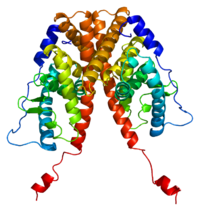
Photo from wikipedia
One-third of breast cancer patients will develop recurrent cancer within 15 years of endocrine treatment. Notably, tumor growth in a hormone-refractory state still relies on the interaction between estrogen receptor… Click to show full abstract
One-third of breast cancer patients will develop recurrent cancer within 15 years of endocrine treatment. Notably, tumor growth in a hormone-refractory state still relies on the interaction between estrogen receptor alpha (ERα) and upregulated coactivators. Herein, we suggest that simultaneous targeting of the primary ligand binding site (LBS) and the coactivator binding site (CABS) at ERα represents a promising alternative therapeutic strategy to overcome mutation-driven resistance in breast cancer. We synthesized two series of compounds that connect the LBS-binder (E)-3-{4-[8-fluoro-4-(4-hydroxyphenyl)-2,3-dihydrobenzo[b]oxepin-5-yl]phenyl}acrylic acid 8 with the coactivator binding site inhibitors (CBIs) 4,6-bis(isobutyl(methyl)amino)pyrimidine or 3-(5-methoxy-1H-benzo[d]imidazol-2-yl)propanoic acid via covalent linkage. The most active benzoxepine-pyrimidine conjugate 31 showed strong inhibition of estradiol-induced transactivation (IC50 = 18.2 nM (ERα) and 61.7 nM (ERβ)) in a luciferase reporter gene assay as well as high antiproliferative effects in MCF-7 (IC50 = 65.9 nM) and tamoxifen-resistant MCF-7/TamR (IC50 = 88.9 nM) breast cancer cells. All heterodimers exhibited two- to sevenfold higher antagonism at ERα (compared with ERβ) and were superior to the acrylic acid precursor 8 in terms of ER antagonism and antiproliferative activity. It was demonstrated on the example of 31 that the compounds did not influence the ERα content in MCF-7 cells and therefore act as pure antiestrogens without downregulating potency. Possible interactions of the CBI at the receptor surface, which enhanced the biological activities, were evaluated using molecular docking studies.
Journal Title: Archiv der Pharmazie
Year Published: 2023
Link to full text (if available)
Share on Social Media: Sign Up to like & get
recommendations!